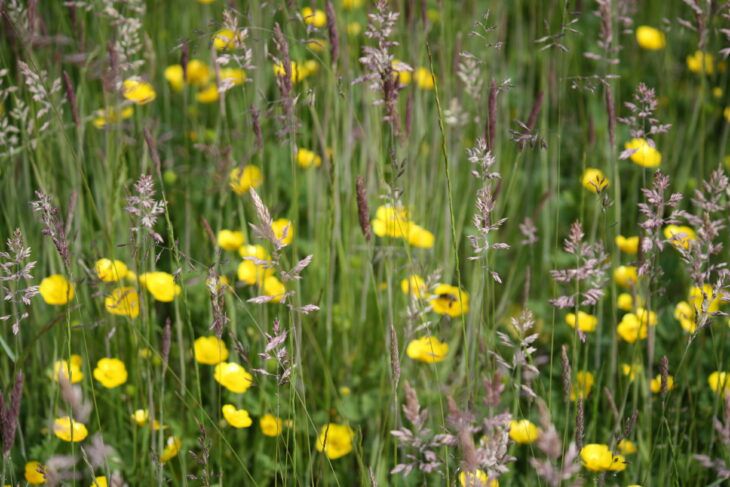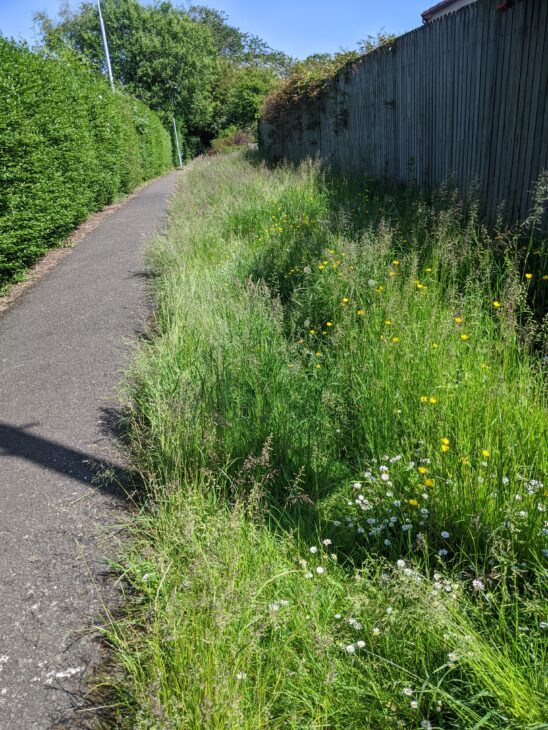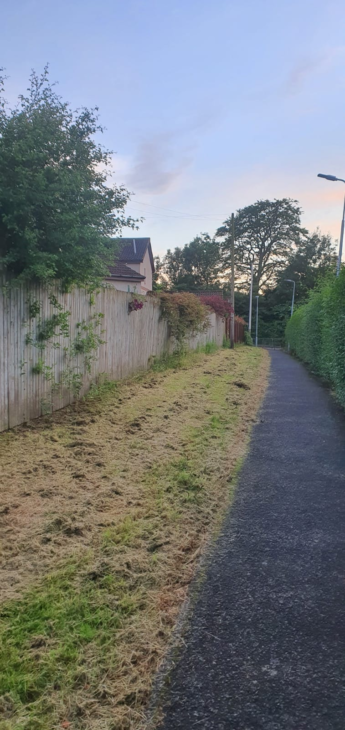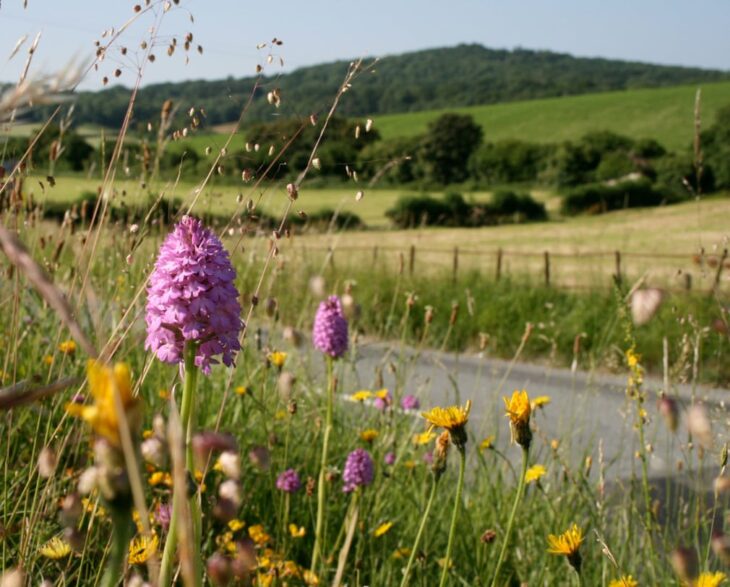Bloomin’ lovely verges
Our Conservation Award intern Siobhan writes about the importance of letting verges be wild.

Buttercup meadow © Siobhan Cantwell
Lockdown Nature
Lockdown has been the new normal since the end of March 2020, and nature has had a chance to take advantage. With less human interference and management practices taking place, grasses are growing, flowers are blooming, and the wildlife is loving it! Pre-lockdown, a walk through our urban areas would mean uniform cut grass with very few, if any, flowers growing and, well, just a bit boring really. Over time we have come to the idea that this manicured look is the ideal since it gives the impression that a place is being looked after and “neat and tidy”.
But who are these areas really being looked after for? Certainly not for the benefit of our wildlife. Now we aren’t talking about the play park that is being managed for the safety of children, or the sections of verge at junctions that need managed for road safety reasons. It is the areas and patches of grass within built up areas, along footpaths and in some cases along road straights, that are being cut short for no other reason than to “look good” for us. This is the perception I hope to change with more people, that natural is better, and to help save our pollinator species such as bees and butterflies.
What should change and why
The photos below were taken along a footpath in Bridgend, West Lothian and show a direct comparison of a verge during summer in lockdown left to grow, compared to the uniform cut that has now been carried out in the month of June 2020 (West Lothian Council commenced grass cutting starting in May 2020 with priority areas).


Footpath verge in Bridgend, West Lothian, left to grow during lockdown (left) and then cut in June (right) © Siobhan Cantwell
There are two main issues to recognise straight away regarding the benefits to pollinator species here. One is that the cut has been carried out in the month of June which is in the middle of the season for species such as the buff-tailed bumblebee (Bombus Terrestris) which is active between the months of March-August. If we think about all the grass verges around urban areas which are cut to this standard, that’s a great reduction of flowering plants available to these species during the time they are most active – such a waste of potential.
The second issue is that the freshly cut grass is left on-site which leaves behind organic matter to decay and in turn increase the soils fertility. This is not good if we want to see a diverse array of flowering plants the following years, as wildflowers generally need soil conditions to be of low fertility. This is so they stand more of a chance against the faster growing species which end up out-competing them, leading to a mostly grass stand.
I’m not suggesting management and cutting regimes should stop altogether. That wouldn’t be any good either as areas would then become a single stand of scrub/bramble thickets which wouldn’t allow for any lower flowering plants to grow. Again, this lowers the number of different plants that could potentially grow within an area which isn’t any good if we want to attract an array of wildlife. So how can we find a balance to manage our verges for the benefit of wildflowers and pollinators?
Verge Management Resources
There are many resources already out there with great information on management practices to benefit wildlife and there are many wildlife charities who are only happy to help and give advice on these matters. So why are we not using this resource already?!
One of these resources comes from Plantlife who have created a best practice guide for managing grassland road verges. The main management tool here is still carrying out grass cutting but it’s all about the timing. Cutting too often, (which is currently happening), means that any flowers growing cannot complete their full cycle and set seed which removes/reduces their presence the following years, therefore reducing diversity.
As I discussed previously above, cutting during high season can also interfere with the activity of pollinator species which could result in certain species populations to decrease. It is usually suggested that no more than one or two cuts each year is carried out. If one cut was the chosen option, then a full cut would be carried out at the end of summer (August/September). If two cuts were preferred, especially for areas with persistent coarse grasses, then the first cut would be carried out in late winter (February/March) and the second at the end of summer. For all cuts, cuttings should be removed from the site to after wildflowers have seeded, ensuring that organic content is not added to the soil.

Blooming road verge © Dominic Murphy / Plantlife, 2019
Why care about verges – some facts and figures from Plantlife
- Over 97% of meadows have been destroyed since the 1930s so our grassy verges have an important role to play in trying to recover this type of habitat.
- In the UK, it could be possible, with proper verge management, to recover a total area of pollinator habitat the size of London, Birmingham, Manchester, Cardiff and Edinburgh combined. So, the potential is huge!
- 700 different species of wildflower grow among our verges which accounts to 45% of our total flora. If only we avoid cutting these our journeys through urban areas could be so much more beautiful.
- There has been a 20% drop in floral species due to poor management and pollution.
Silver linings
Since we have come out of lockdown and restrictions are slowly lifted, we start to feel like some things are going back to some sort of normal which most of us have been looking forward to. However, when it comes to the cutting of the verges, I would have liked to have seen changes in their management but unfortunately for in my area it’s been business as usual.
It is not all bad news though! One place that is making the most of its verges for wildlife is Devon. The county council’s grass cutting policy means it is only carried out where/when necessary (such as for road and sign visibility reasons) so cutting is reduced, and cut grass is removed from site. They also encourage communities to get involved in the management of verges and share information on how to do this on their web page. I would like to see many more councils follow their example.
How you can help
Plantlife have a campaign to save wildflowers on road verges all across the UK. They have provided an open letter in which you can digitally sign and send to your own council to encourage them to change their management practices and leave verges wild to benefit our wildlife!
Siobhan Cantwell, Conservation Award Intern, Jupiter Urban Wildlife Centre
Help protect Scotland’s wildlife
Our work to save Scotland’s wildlife is made possible thanks to the generosity of our members and supporters.
Join today from just £3 a month to help protect the species you love.
Preface
Our Conservation Award intern Siobhan writes about the importance of letting verges be wild. Buttercup meadow © Siobhan Cantwell Lockdown Nature Lockdown has been the new normal since the end …
